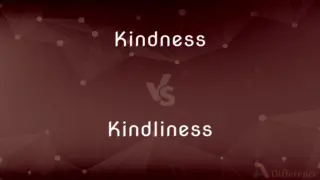Baluster vs. Balustrade — What's the Difference?
By Tayyaba Rehman & Maham Liaqat — Updated on April 4, 2024
Balusters are individual vertical posts, while a balustrade is a series of balusters supporting a rail.

Difference Between Baluster and Balustrade
Table of Contents
ADVERTISEMENT
Key Differences
Balusters are vertical, molded shafts, columns, or posts often found on staircases, porches, and balconies, providing structural and aesthetic functions. They are typically made of wood, stone, or metal and come in various designs, from simple to intricate. On the other hand, a balustrade refers to a row of balusters topped by a rail, serving both a decorative and safety role. It acts as a protective barrier and is often used in architecture to enhance the visual appeal of staircases, balconies, and bridges.
Balusters can be seen as the individual components that make up the larger structure of a balustrade. Each baluster plays a crucial role in supporting the handrail and ensuring the integrity of the barrier. Whereas the balustrade encompasses the entire assembly of balusters, rails, and sometimes additional elements like newel posts, which mark the beginning and end of the balustrade.
The design of a baluster is key to the overall appearance and theme of a space. They can range from classic to contemporary styles, affecting the aesthetic of the entire balustrade system. Conversely, the design of a balustrade as a whole takes into consideration the coordination of its parts to create a cohesive look that complements the surrounding architecture.
In terms of installation, balusters are installed with spacing that meets safety standards to prevent falls, especially in elevated areas. The spacing is crucial for the balustrade’s functionality, ensuring that it serves as an effective barrier. On the contrary, the installation of a balustrade requires careful planning to ensure that the balusters are correctly aligned and the rail is securely attached, providing a sturdy and safe barrier.
Maintenance of balusters may involve regular cleaning, repair, or replacement of individual components, depending on the material and exposure to elements. Meanwhile, maintaining a balustrade involves inspecting the entire structure for stability, especially the connections between balusters and the rail, to ensure safety and longevity.
ADVERTISEMENT
Comparison Chart
Definition
A vertical, molded shaft serving as a structural element.
A series of balusters supporting a rail, forming a barrier.
Function
Supports the handrail and contributes to the barrier's strength.
Serves as a protective barrier and adds aesthetic value.
Installation
Installed individually, with specific spacing for safety.
Installed as a complete system, including rails and sometimes additional elements.
Design Influence
Affects the aesthetic of the structure in detail.
Influences the overall appearance and theme of the surrounding architecture.
Maintenance
May require individual repair or replacement.
Requires inspection and maintenance of the entire structure for safety and integrity.
Compare with Definitions
Baluster
An architectural element found in many traditional buildings.
Each baluster was carved with meticulous detail.
Balustrade
Adds both safety and aesthetic appeal to staircases, balconies, and bridges.
The glass balustrade offered unobstructed views of the landscape.
Baluster
Can be highly decorative or simple in design.
The simple balusters complemented the minimalist architecture.
Balustrade
Often encompasses the balusters, the top rail, and sometimes a bottom rail.
The balustrade’s intricate design became the focal point of the room.
Baluster
A vertical support for staircases and balconies.
The wooden balusters were spaced evenly along the edge.
Balustrade
Requires precise installation for safety and durability.
The contractor ensured the balustrade was securely anchored.
Baluster
A short column or post that supports a rail.
The staircase was lined with marble balusters.
Balustrade
A series of balusters supporting a rail, used as a barrier.
The balcony was enclosed by a stone balustrade.
Baluster
Often made from materials like wood, stone, or metal.
The wrought iron balusters added a gothic feel to the decor.
Balustrade
Can vary greatly in style, from traditional to modern.
The sleek, stainless steel balustrade gave the staircase a contemporary look.
Baluster
A baluster is a vertical moulded shaft, square, or lathe-turned form found in stairways, parapets, and other architectural features. In furniture construction it is known as a spindle.
Balustrade
A railing supported by balusters, especially one forming an ornamental parapet to a balcony, bridge, or terrace.
Baluster
A short decorative pillar forming part of a series supporting a rail or coping.
Balustrade
A rail and the row of balusters or posts that support it, as along the front of a gallery.
Baluster
One of the upright, usually rounded or vase-shaped supports of a balustrade.
Balustrade
A row of balusters topped by a rail, serving as an open parapet, as along the edge of a balcony, terrace, bridge, staircase, or the eaves of a building.
Baluster
An upright support, such as a furniture leg, having a similar shape.
Balustrade
A row of balusters topped by a rail, serving as an open parapet, as along the edge of a balcony, terrace, bridge, or the eaves of a building, or as a guard railing on a staircase; - it serves as a guard to prevent people from falling.
Baluster
One of the supporting posts of a handrail.
Balustrade
A railing at the side of a staircase or balcony to prevent people from falling
Baluster
(architecture) A short column used in a group to support a rail, as commonly found on the side of a stairway; a banister. 17
Baluster
A small column or pilaster, used as a support to the rail of an open parapet, to guard the side of a staircase, or the front of a gallery. See Balustrade.
Baluster
One of a number of closely spaced supports for a railing
Common Curiosities
What is a balustrade?
A balustrade is an architectural feature that consists of a series of balusters supporting a rail, forming a protective barrier or parapet.
What materials are commonly used for balusters?
Balusters can be made from wood, stone, metal, or even glass, depending on the architectural requirements and aesthetic preferences.
What is a baluster?
A baluster is a vertical, molded shaft, column, or post that supports a rail, usually part of a staircase, balcony, or porch.
How are balustrades designed for safety?
Balustrades are designed with specific height and baluster spacing requirements to prevent falls and ensure the safety of occupants, especially in elevated areas.
How do balusters and balustrades differ in function?
Balusters serve as the individual supports for the rail, contributing to the structural strength of the barrier, whereas a balustrade provides a safety barrier and adds aesthetic value to buildings and structures.
Can balusters be decorative?
Yes, balusters often feature decorative designs, ranging from simple shapes to intricate carvings, contributing to the overall aesthetic of the balustrade and the surrounding architecture.
How does the design of a balustrade impact its surrounding environment?
The design of a balustrade can significantly impact the visual appeal and thematic consistency of its environment, enhancing the architectural beauty of spaces.
Can a balustrade exist without balusters?
Typically, no. Balustrades are defined by the presence of balusters. However, modern designs may use different elements to create a barrier that functions similarly to a traditional balustrade.
Are there regulations governing the design of balustrades?
Yes, there are building codes and regulations that specify the minimum requirements for balustrade design, including height and spacing, to ensure safety.
What is the importance of maintenance for balusters and balustrades?
Regular maintenance is crucial to ensure the stability, safety, and longevity of balusters and balustrades, especially for those exposed to environmental elements.
What are the key considerations when installing a balustrade?
Key considerations include ensuring structural integrity, adhering to safety standards, and choosing a design that complements the architectural style of the space.
How does one choose materials for balusters and balustrades?
Material choice is influenced by factors such as durability, maintenance requirements, aesthetic preferences, and environmental conditions.
Can balustrades be customized?
Yes, balustrades can be highly customized in terms of design, material, and dimensions to fit specific architectural needs and personal tastes.
Share Your Discovery

Previous Comparison
Physic vs. Laxative
Next Comparison
Kindness vs. KindlinessAuthor Spotlight
Written by
Tayyaba RehmanTayyaba Rehman is a distinguished writer, currently serving as a primary contributor to askdifference.com. As a researcher in semantics and etymology, Tayyaba's passion for the complexity of languages and their distinctions has found a perfect home on the platform. Tayyaba delves into the intricacies of language, distinguishing between commonly confused words and phrases, thereby providing clarity for readers worldwide.
Co-written by
Maham Liaqat













































